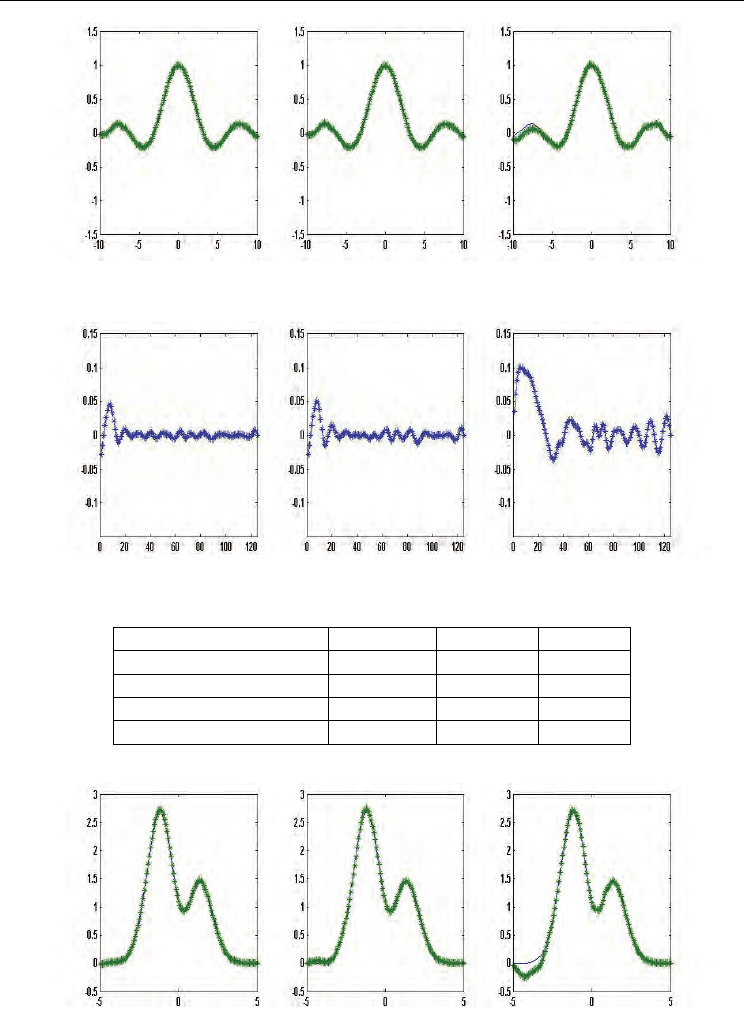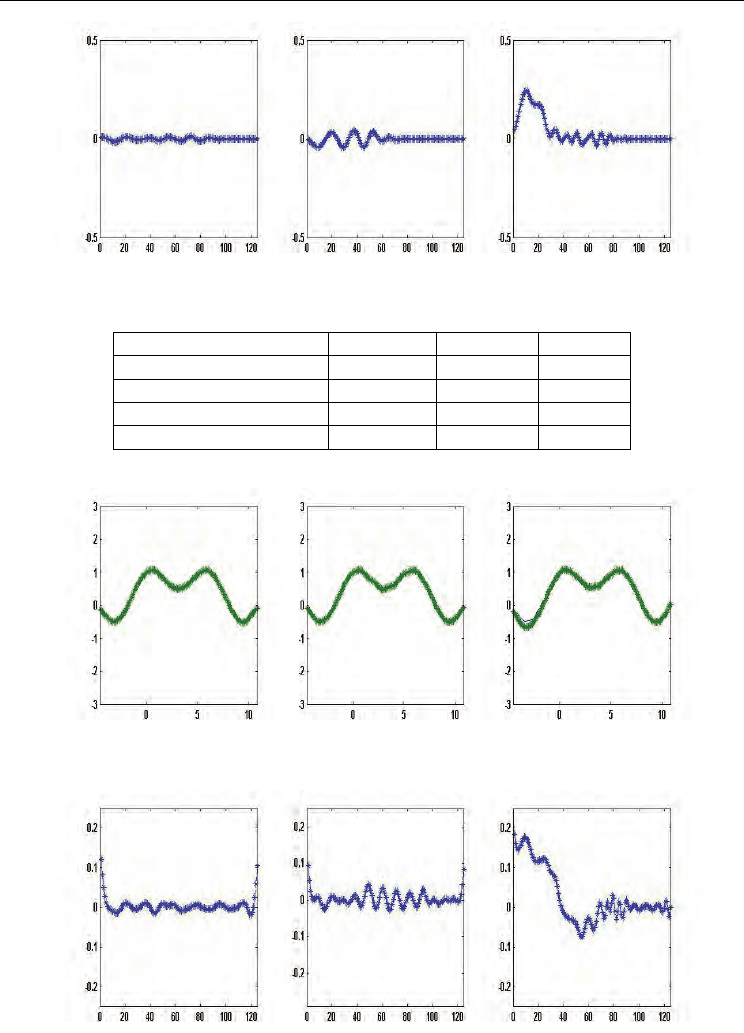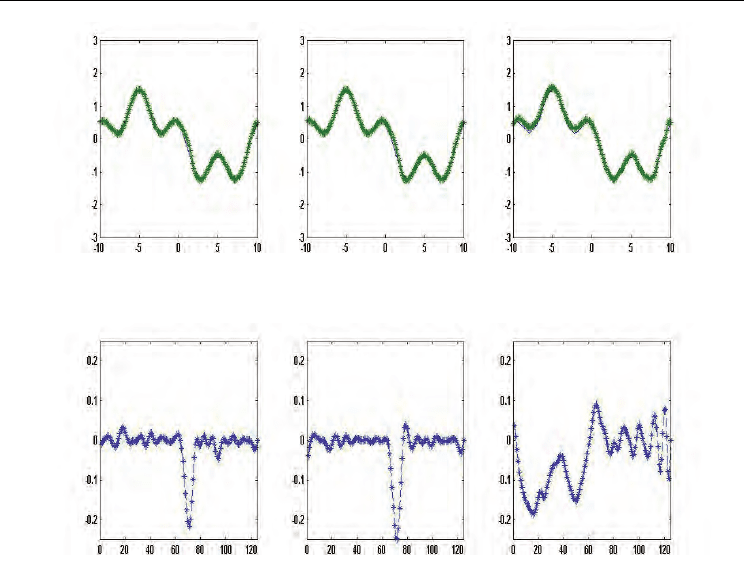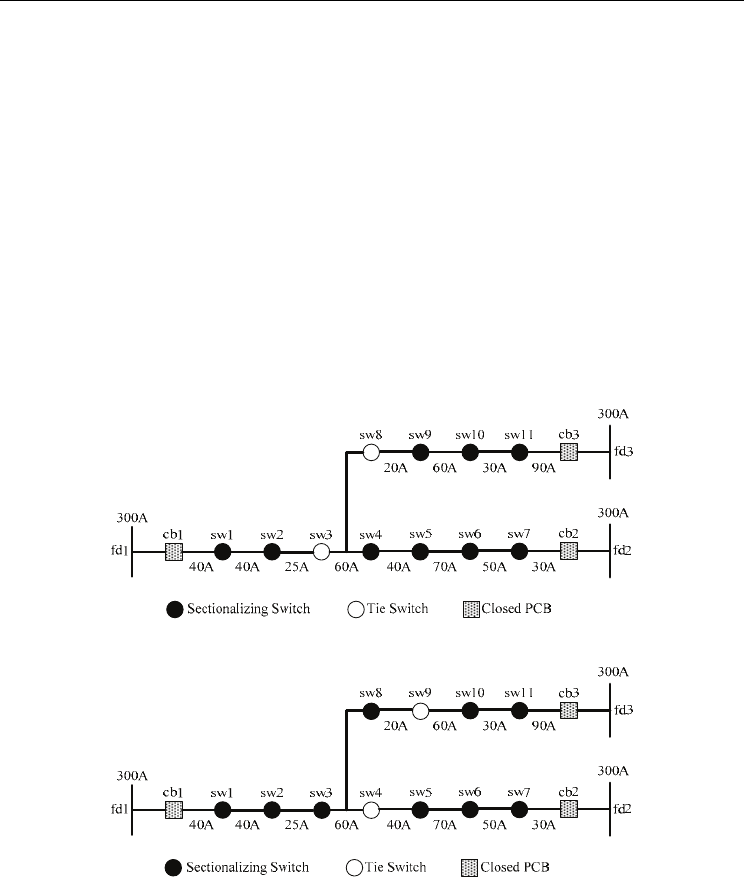Lazinica A. (ed.) Particle Swarm Optimization
Подождите немного. Документ загружается.


A Radial Basis Function Neural Network with Adaptive Structure
via Particle Swarm Optimization
431
Figure 5. Curves of RBFNN output and real data in example 2. (solid-line represents the real
data, dashed-line represents the output data)
Figure 6. The errors between the real data and approximations in example 2
Example 3.
PSO-based GA-based K-means
RMSE for training data 0.0056 0.0173 0.1271
RMSE for testing data 0.0057 0.0188 0.0803
Maximal error 0.0134 0.0432 0.2441
Number of hidden node 24 22 30
Table 4. Comparison between the three approaches in example 3
Figure 7. Curves of RBFNN output and real data in example 3. (solid-line represents the real
data, dashed-line represents the output data)

Particle Swarm Optimization
432
Figure 8. The errors between the real data and approximations in example 3
Example 4.
PSO-based GA-based K-means
RMSE for training data 0.0079 0.0112 0.0337
RMSE for testing data 0.0192 0.0292 0.0740
Maximal error 0.1217 0.0939 0.1854
Number of hidden node 19 31 30
Table 5. Comparison between the three approaches in example 4
Figure 9. Curves of RBFNN output and real data in example 4. (solid-line represents the real
data, dashed-line represents the output data)
Figure 10. The errors between the real data and approximations in example 4

A Radial Basis Function Neural Network with Adaptive Structure
via Particle Swarm Optimization
433
Example 5.
PSO-based GA-based K-means
RMSE for training data 0.0460 0.0519 0.0637
RMSE for testing data 0.0546 0.0564 0.0867
Maximal error 0.3056 0.3236 0.2208
Number of hidden node 20 21 30
Table 6. Comparison between the three approaches in example 5
Figure 11. Curves of RBFNN output and real data in example 5. (solid-line represents the
real data, dashed-line represents the output data)
Figure 12. The errors between the real data and approximations in example 5
Example 6.
PSO-based GA-based K-means
RMSE for training data 0.0079 0.0092 0.0690
RMSE for testing data 0.0439 0.0509 0.0859
Maximal error 0.2159 0.2486 0.1855
Number of hidden node 29 27 30
Table 7. Comparison between the three approaches in example 6

Particle Swarm Optimization
434
Figure 13. Curves of RBFNN output and real data in example 6. (solid-line represents the
real data, dashed-line represents the output data)
Figure 14. The errors between the real data and approximations in example 6
5.3 Discussion
In the simulation results in tables, PSO-based approach has lower RMSE for training data
and testing data. It means that over fitting does not happen in the proposed approach. From
figures of the curves of RBFNN output and real data, the approximated curves by PSO-
based approach is closer to the real data than these by others. From figures of the
approximated errors, it could be shown that PSO-based approach results small error in most
of sample, whereas the K-means approach has largest error.
We know that RBFNN needs different number of hidden node and cluster radius for
different complexities. K-means approach usually performs a larger error because it is not
able to decide a suitable number of hidden node. Though GA-based approach decides a
suitable number of hidden node, its cluster radius is not good enough to classify whole data.
The proposed approach is able to find out the optimal cluster radius to further decide a
number of hidden node because PSO has better capacity of global searching than GA.
6. Conclusion
This paper has presented a novel approach for self-structure RBFNN. A very important step
for the RBFNN training is to decide a proper number of hidden node. If the number of
hidden node does not chosen properly, the RBFNN may present poor global generalization
capability, slow training speed, and the requirement of large memory space. Therefore, to

A Radial Basis Function Neural Network with Adaptive Structure
via Particle Swarm Optimization
435
decide a suitable cluster distance factor (
ε
) is the crucial condition for creating an optimal
self-structure RBFNN. This paper proposed a PSO-based approach for searching the optimal
ε
; further, RBFNN is able to determine the optimal number of hidden node automatically.
For proofing benefits of the proposed PSO-based approach, the simulations consisting of six
nonlinear system modeling were tested; meanwhile, GA-based approach and K-means
approach were also carried out for comparison. Simulation results show that the PSO-
RBFNN algorithm outperforms the GA-RBFNN and K-means methods by the minimal
training RMSE and the minimal testing RMSE.
7. References
Aiguo, S. & Jiren, L. (1998). Evolving Gaussian RBF network for nonlinear time series
modeling and prediction, IEEE Electronics Letters, Vol. 34 (12), pp. 1241-1243
Broomhead, D. S. & Lowe, D. (1988). Multivariable functional interpolation and adaptive
networks, Complex Systems, Vol. 2, pp. 321-355
Back, T.; Hammel, U. & Schwefel, H. P. (1997). Evolutionary computation: comments on the
history and current state, IEEE Trans. on Evolutionary Computation, Vol. 1, pp. 3-17
Chen, S.; Wu, Y. & Luk, B. L. (1999). Combined genetic algorithm optimization and
regularized orthogonal least squares learning for radial basis function networks,
IEEE Trans. on Neural Networks, Vol. 10 (5), pp. 1239-1243
Chen, S. (1995). Nonlinear time series modeling and prediction using Gaussian RBF
networks with enhances clustering and RLS learning, Electronics Letters, Vol. 31, No.
2, pp. 117-118
Eberhart, R. C. & Kennedy, J. (1995). A new optimizer using particle swarm theory,
Proceeding of 6th Int. Symp. Micro Machine and Human Science, pp. 39-43
Freeman, J. A. S. & Saad, D. (1995). Learning and generalization in radial basis function
networks, Neural Computation, Vo. 9 (7), pp. 1601-1622
Gudise, V. G. & Venayagamoorthy, G. K. (2003). Comparison of Particle Swarm
Optimization and Backpropagation as Training Algorithms for Neural Networks,
Proceeding of IEEE Swarm Intelligence Symposium, pp. 110-117
Karayiannis, N.B & Mi, G.W. (1997). Growing radial basis neural networks : merging
supervised and unsupervised learning with network growth techniques, IEEE
Trans. on Neural Networks, Vol. 8 (6), pp. 1492-1506
Lin, C. L.; Hsieh, S. T.; Sun, T. Y. & Liu, C. C. (2005). PSO-based learning rate adjustment for
blind source separation, Proceeding of International Symposium on Intelligent Signal
Processing and Communications Systems, pp. 181-184
Lowe, D. (1989). Adaptive radial basis function nonlinearities, and the problem of
generalization, Procedings of IEE International Conference on Artificial Neural Networks,
pp. 171-175
Moddy, Y. & Darken, C. J. (1989). Fast learning in network of locally tuned processing
unites, Neural computation, Vol.1, pp. 281-294
Song, A. & Lu, J. (1988). Evolving Gaussian RBF network for nonlinear time series modeling
and prediction, Electronics Letters, Vol. 34, No.12, pp. 1241-1243

Particle Swarm Optimization
436
Sun, T. Y.; Hsieh, S. T. & Lin, C. W. (2005). Particle Swarm Optimization Incorporated with
Disturbance for Improving the Efficiency of Macrocell Overlap Removal and
Placement, Proceeding of The 2005 International Conference on Artificial Intelligence, pp.
122-125
Yunfei, B. & Zhang, L. (2002). Genetic algorithm based self-growing training for RBF neural
Network, IEEE Neural Networks, Vol. 1, pp. 840-845
Zheng, N.; Zhang, Z.; Shi, G. & Qiao, Y. (1999). Self-creating and adaptive learning of RBF
networks: merging soft-completion clustering algorithm with network growth
technique, Proceeding of International Joint Conference on Neural Networks, Vol. 2, pp.
1131-1135
27
A Novel Binary Coding Particle Swarm
Optimization for Feeder Reconfiguration
Men-Shen Tsai and Wu-Chang Wu
National Taipei University of Technology
Taipei, Taiwan
1. Introduction
Power distribution systems are formed by many inter-connected feeders. Each feeder is
further partitioned into many load-zones by switches. These switches can be divided into
two categories: normally closed sectionalizing-switches and normally opened tie-switches.
During normal operation, the structure of distribution system must be maintained in radial
structure by properly adjusting the status of the switches. The distribution system can be
reconfigured by changing the status of these switches while maintaining the radial
structure. The feeder reconfiguration serves several purposes, for example, reducing power
losses, maintaining load balance and enhancing service reliability. The mean of a switch
operation plan is that by changing the status of sectionalizing-switches and tie-switches,
loads can be transferred from one feeder to an adjacent feeder to redistribute loads without
violating the operation limitations. However, great deals of switches exist on distribution
systems. The number of possible solutions for feeder reconfiguration is increased in
exponential order when the number of switches on distribution system increases. Thus
selecting the best switch operation plan from all feasible solutions can be considered as an
NP-Complete problem. Because the status of switches can be represented as ‘1‘ or ‘0’, the
problem of feeder reconfiguration can also be regarded as ‘1’ and ‘0’ permutation
combinatorial optimization problems.
Researchers studied the feeder reconfiguration problems using different methods in the past
decades. The results of these researches provide acceptable solutions for feeder
reconfiguration problems. Heuristic methods to minimize power losses and improve the
searching speed were proposed in (Baran & Wu, 1989). Soft computing approaches were
applied to the problem extensively as well, for example, neural network (Kim et al., 1993),
simulated annealing (SA) (Chang & Kuo, 1994), genetic algorithm (GA) (Nara et al., 1992;
Kitayama & Matsumoto, 1995) and evolutionary programming (EP) (Hsiao, 2004; Hsu &
Tsai, 2005). Algorithms based on concept of mimicking swarm intelligent are popular in
recent years. For instance, ant colony optimization (ACO) (Teng & Lui, 2003; Carpaneto &
Chicco, 2004; Khoa & Phan, 2006) and particle swarm optimization (PSO) (Chang & Lu,
2002) are the algorithms that can be applied to the field of optimization problems. These
algorithms are applied to the problems of power distribution system gradually.
This research will apply the concept of PSO algorithm that is a novel and suitable algorithm
for solving combinatorial optimization problems. Kennedy and Eberhart (Kennedy &

Particle Swarm Optimization
438
Eberhart, 1995; Shi & Eberhart, 1998) proposed PSO (typical PSO) in 1995. The PSO can be
treated as the branch of the evolutionary algorithms and it introduces the concept of swarm
intelligent. There are many similarities between PSO and Genetic Algorithm (GA). Both
algorithms produce an initial solution set randomly at first. Through iterations of the
evolution process, optimal solution can be obtained. The major difference between GA and
PSO is that PSO has no explicit selection, crossover and mutation operations (Eberhart &
Shi, 1998). Searching process in PSO is based on the previous best solution of a particle and
the best solution of the population so far to update particle’s information. That means the
particles will share the best information between each other and lead the particles moving
toward the target. Due to the searching mechanism designed in PSO, the probability of
falling into local solution for PSO algorithm can be reduced. Also, the concept of PSO is
simple and is easy to implement than GA. Thus, PSO can be a powerful algorithm to aid and
speed up the decision-making process for feeder reconfiguration problems to identify the
best switching plan.
As mentioned previously, feeder reconfiguration problems are non-linear discrete
optimization problems. However, the typical PSO is designed for continuous function
optimization problems; it is not designed for discrete function optimization problems.
Fortunately, Kennedy and Eberhart proposed a modified version of PSO called Binary
Particle Swarm Optimization (BPSO) that can be used to solve discrete function
optimization problems (Eberhart & Kennedy, 1997). Although BPSO can be applied to solve
the discrete optimization problems, there are still problems when BPSO is applied for feeder
reconfiguration problems. In feeder reconfiguration problems, there are a large number of
tie-switches. Randomly choosing the locations of these tie-switches will cause outages or
non-radial structure in distribution systems. In (Chang & Lu, 2002), BPSO is used to solve
the feeder reconfiguration problems and the method they proposed avoided the problem of
unsuitable numbers of tie-switches. The concept of (Chang & Lu, 2002) is based on BPSO
and the moving velocity of particle is defined in terms of probabilities. Instead of BPSO used
in (Chang & Lu, 2002), this research tries to construct a more feasible discrete PSO scheme
based on typical PSO for feeder reconfiguration. The method proposed in this research
modifies the operators of PSO’s formula based on the characteristics of both the status of
switches and the shift operator to construct the binary coding particle swarm optimization
for feeder reconfiguration. Minimizing total line losses and load balancing without violating
operation constraints and maintaining radial structure are the two objective functions in this
research. The simulations will be performed and the results are used to compare the
proposed method, the method proposed in (Chang & Lu, 2002) and BPSO to verify the
performance and effectiveness. A distribution system in Taiwan Power Company (TPC) is
used in this study to verify the stability and usefulness of the proposed algorithm.
2. Problem Statement
There are all kinds of loads on distribution systems and these loads distributed non-evenly
on the distribution feeders. The uneven load distribution on feeders may cause the
conductor overloading or transformer load unbalancing on distribution systems during
emergency operation. Fig. 1 is a simple 3-feeder distribution system. The ampacity of each
feeder is 300A. The total loads on each feeder are 105A, 250A and 200A respectively. This
configuration is considered as an unbalanced distribution system when the feeder loading is
concerned. The feeder reconfiguration can be performed by opening/closing of

A Novel Binary Coding Particle Swarm Optimization for Feeder Reconfiguration
439
sectionalizing-switches and tie-switches on distribution systems to reduce line losses or
increase the system reliability. Therefore, feeder reconfiguration can redistribute the loads
and is a common practice for the distribution system operators to avoid the problems of the
conductor/transformer overloading or unbalancing on distribution feeders or transformers.
Fig. 2 is the result of feeder reconfiguration from Fig. 1. The loads on each feeder are 185A,
190A and 180A respectively after reconfiguration. As a result, the system is operated in a
more balanced way. However, some constraints should be considered during feeder
reconfiguration. These constraints include: the radial structure of distribution system must
be maintained, all zones must be served, feeder capacity should not be exceeded and feeder
voltage profile should be maintained. As mentioned earlier, the feeder reconfiguration
problems can be treated as ‘1’ & ‘0’ permutation combinatorial optimization problems. ‘1’
represents a normally closed switch; while ‘0’ represents a normally opened switch.
Considering a simple system shown in Fig. 1, the order of switch permutation is sw1, sw2,
…, sw11 in turn. Thus, the status of switch permutation of the system in Fig. 1 can be
expressed as [1 1 0 1 1 1 1 0 1 1 1]. The result of feeder reconfiguration is shown in Fig. 2, and
the switch permutation becomes [1 1 1 0 1 1 1 1 0 1 1].
Figure 1. A simple 3-feeders distribution system
Figure 2. Result of feeder reconfiguration
Some objectives such as minimize the total line losses, minimize the numbers of operating
switches, minimize voltage drop and load balance index are considered during feeder
reconfiguration in general. Two objectives are considered in this research. The first is to
minimize the total line losses during normal operation. By doing so, the operation of
distribution system will be more economic and effective. The second objective is to
distribute loads on feeders evenly. Balanced feeder loads can increase the opportunity of

Particle Swarm Optimization
440
load transfer during emergency conditions and improve system reliability. The method
proposed in this research also ensures that structure is maintained in radial and the
ampacity of each conductor is kept within allowable limits. “Concentric load model” is used
in this research for calculating branch currents. The line losses can be formulated as follows:
2
1
Re
n
loss i i
i
FIz
=
⎛⎞
=⋅
⎜⎟
⎝⎠
∑
(1)
where F
loss
is the total real power losses of distribution feeders, n is the total numbers of
zones in distribution system, I
i
is the current magnitude of the i-th zone and z
i
is the line
impendence of the i-th zone. The load balance index is expressed as following:
()
∑∑
==
−=
k
m
k
n
nmbalanceload
CapCapF
11
2
_
(2)
where
k is number of feeder. Cap
m
or Cap
n
represents the total load of feeder m and n
respectively. The total feeder loads can be calculated as following:
∑
=
j
jii
LoadCap
,
(3)
where, Load
i,j
∈ Feeder
i
, i is the feeder number, and j is the load zone number within feeder
i. In order to calculate the fitness value of the system represented by a particle, the method
proposed in (Hsu & Tsai, 2005) is used to integrate the two object functions.
3. Particle Swarm Optimization
3.1 Typical Particle Swarm Optimization
A considerable amount of incredible social behavior and great intelligent exist in nature
such as ant colonies, bird flocking, animal herding and fish schooling. Although the ability
of individual is limited, the population can achieve the difficult target though cooperation
with each other. Note that there is no centralized control in population. The behavior of
individual depends on interacting with one another and with their environment only. These
simple behaviors among individuals can lead population make themselves toward global
behavior. Thus, completing a goal by aggregating the individuals and cooperating with each
other that could be called swarm intelligent. Particle Swarm Optimization is one of the
optimization algorithms provided with the concept of swarm intelligent. Original concept of
PSO came from the study of simulating behavior of bird flocking to look for food. A possible
solution for each problem can be represented as a particle that is just like a bird flocking in a
D-dimensional searching space. Each individual particle has a fitness value that is evaluated
by a fitness function to pick a good experience for itself and population respectively. The
particles of population is initialized randomly first. A particle changed its searching
direction based on two values or experiences during each iteration. The first one is the best
searching experience of individual so far and it is called pbest. Another one is the best result
obtained so far by any particle in the population and it is called gbest. When pbest and gbest
are obtained, a particle updates its velocity and position based on (4) and (5). Lastly, the
